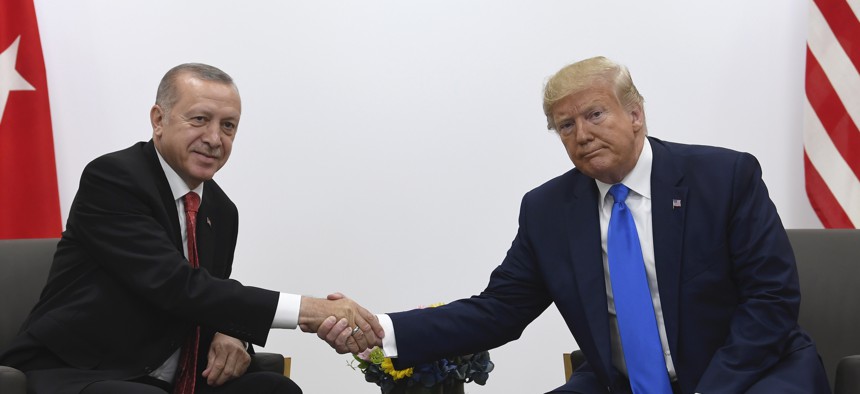
President Donald Trump, right, shakes hands with Turkish President Recep Tayyip Erdogan, left, during a meeting on the sidelines of the G-20 summit in Osaka, Japan, Saturday, June 29, 2019. AP Photo/Susan Walsh
Trump Is Complicit in Erdoğan’s Violence
Now the war in Syria has a victor. And it’s not the U.S.
The president and his men are spinning furiously to try to wrench President Donald Trump’s foot out of the trap he stepped in by supporting Turkey’s military assault into Syria.
They’re trying to avert our eyes from the fact that the president approved the military destruction of partners who did the hardest, most dangerous work of fighting ISIS. While the Syrian Democratic Forces aren’t American allies—only Congress has that gift in its power—they have suffered 11,000 casualties in the anti-ISIS campaign, allowing U.S. forces to suffer only five. And they have been holding ISIS terrorists and supporters in prisons and detention camps, which must now receive less oversight as the SDF rush to stave off their own destruction.
Abandoned by the United States and lacking confidence that they could withstand the Turkish onslaught (since they have no air power and we required them to dismantle their land defenses), the SDF bought the only protection on offer: Bashar al-Assad’s. That they handed over territory they years ago wrested from his rapacious control, and put their fate in his hands knowing he has bled dry all other rebels who returned, is a real measure of their desperation. They are simply trying to live to fight another day.
Their surrender in effect ends the Syrian civil war with Assad as its victor, Russia as its beneficiary, and the United States one of its losers. The cost of getting any cooperation from potential partners in future conflicts has skyrocketed. The U.S. also accrued both shame and humiliation; we’ve broken our promises, and Russian troops are posting videos of themselves taking over deserted U.S. bases.
Related: The US Is Leaving Syria. Russia Is Moving In.
Related: ‘Silent Warriors’ Speak Out Against Trump’s Syria Turnaround
Related: Trump Made His Real Syria Mistakes Months Ago
Trump pretends not to care, tweeting, “Anyone who wants to assist Syria in protecting the Kurds is good with me, whether it is Russia, China, or Napoleon Bonaparte. I hope they all do great, we are 7,000 miles away!” Which sounds an awful lot like green-lighting Turkey’s invasion. (And by the way, Osama bin Laden was 7,000 miles away, too.)
The price of this latest reckless and destructive folly is dawning on the White House, though: Vice President Mike Pence, Secretary of State Mike Pompeo, and Secretary of Defense Mark Esper all tried to mop up the mess by denying reality—flatly rejecting that the president had okayed the invasion.
When those efforts didn’t stanch the bleeding of the administration’s credibility, the White House dispatched Pence and National Security Adviser Robert O’Brien to Ankara to try to find a face-saving solution. Esper will go to Brussels “to press our other NATO allies to take collective and individual diplomatic and economic measures in response to these egregious Turkish actions.”
America’s NATO allies are aghast at Turkey’s brutality, but they also consider U.S. actions egregious. French Foreign Minister Jean-Yves Le Drian said, “President Trump doesn’t seem to have opposed the operation the Turks are carrying out today, even though much firmer positions are being asserted today.”
It is important for U.S. troops and for the U.S. public to hear the Pentagon’s civilian leader explain military policies. And Esper, to his credit, isn’t hiding from the media. But the contortions he’s performing to justify the president’s decisions are painful to watch: “To be clear, we are not abandoning our Kurdish partner forces,” he told reporters, “and U.S. troops remain with them in other parts of Syria. The impulsive action of President Erdoğan to invade northern Syria has put the United States in a tough situation."
Both the president and Esper make it sound as though there were no alternativesto either fighting a two-front war against both Syria and Turkey or completely withdrawing U.S. forces. This is the kind of straw man that made Republicans scoff at President Barack Obama and his acolytes, when they suggested they had to either abandon Iraq or avoid Syria. There is a wider range of choices available than doing nothing or landing an invasion force at Normandy, to use Trump’s favorite test of allied worth.
Even operating within the constraints that Trump has foolishly adopted, there are actions the U.S. could—and should—take to mitigate the damage. If he must allow Turkey to create a 20 km “safe zone” in Syrian territory, the U.S. should take responsibility for making it actually safe, because what is currently a military onslaught could quickly become a humanitarian crisis.
U.S. forces have succeeded in preventing conflagration between Turkey and the SDF for years, despite unmitigated Turkish hostility to the YPG (Kurdish fighters with links to the PKK terrorist group operating in Turkey). We could negotiate the terms of a cease-fire and provide the buffer between Turkish forces and the SDF while the territory is handed over to Turkey. Turkey would achieve its stated objective of an SDF-free buffer, the SDF would survive, and the transition could occur with minimal horror for civilians.
After the 1991 Gulf War, the United States created a safe zone in northern Iraq, providing security and facilitating humanitarian assistance for the Iraqis living or fleeing there. As Jim Jones argued in 2017, Operation Provide Comfort sheltered Iraqis from their government, provided the stability that encouraged economic development, and nurtured a generation of leaders who have been a positive political force in Iraq and friendly to American interests. By putting the welfare of northern Syria’s civilians at the center of our policy, we might be able to claw back some respectability.
Assad is angling for reconstruction money, and so might allow this arrangement—and, as both Turkey’s and the SDF’s military successes show, couldn’t prevent it. Russia, too, wants Syria rebuilt, but doesn’t have the money to spend on it. Organizing relief efforts in northern Syria would give the U.S. a way to contribute to reconstruction without bolstering the Assad regime, since the territory won’t be controlled by Syrian forces.
It’s not too late for the administration to see how very costly a bill the president has presented to our country. We’ve lost the argument about culpability; there is no escaping that Trump is complicit in Erdoğan’s violence. But if we move fast with a proposed buffer, before the long-term consequences of Trump’s support for Turkey’s invasion are manifest, we might still be able to get partners to help us, and mitigate the damage.
NEXT STORY: LIVESTREAM: 2019 Global Security Forum Day 2
